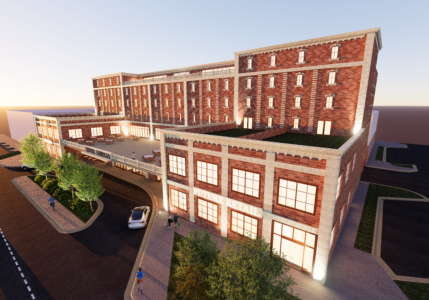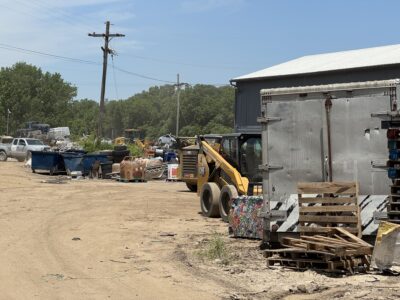
A 57% down payment and years of savings to buy a Lawrence home; a look at latest affordability report
Plus, how much has affordability changed since 1970?

photo by: AdobeStock image
New Row House Construction with wood sheathing and asphalt roof
OK, old-timer, maybe you did have a route to school that was uphill both ways. But I know there is one challenge you didn’t have: Today’s housing market.
Thank your lucky stars.
A new report shows that an average income-earning household in Lawrence that is looking to buy an average-priced home in Lawrence would need to make a 57% down payment on that house in order to be able to reasonably afford the mortgage.
Here’s the rest of that calculation: It would take that average household about 17 years to come up with that down payment, if it simply were socking away a reasonable amount from their paychecks each month and placing it in a conservative investment fund.
What were you saying about that hill again?
Say what you want, but I’m almost certain that was nowhere near the case in 1970s Lawrence. In fact, I’ll largely prove it, with the help of old Journal-World classified pages, in just a moment.
But first, let’s unpack this most recent report, which is from the financial website Upgraded Points. Using home prices from Zillow and income figures from the Census Bureau, the website has created a unique way to measure housing affordability in about 600 different cities.
It calculates how many years it would take a household that earns the city’s median income to save for a down payment on the average-priced home in the city. The down payment amount is determined by the widely accepted benchmark that a household should not spend more than 30% of its gross income on a mortgage payment. The number of years it would take a family to save for the down payment amount is calculated by assuming the household is able to save 10% of its gross income per year, and it invests the money in an account that earns 5% a year.
While you could quibble with those assumptions, they generally are reasonable. They produce a result that many Lawrence leaders may find reasonable but objectionable nonetheless: Lawrence is highly unaffordable, especially for the surrounding area.
Here’s a look at the size of the required down payment and the number of years it would take an average household to save the amount for each city in Kansas that was measured:
• Lawrence: 57% down payment, 17.3 years of savings
• Overland Park: 36% down payment, 11 years of savings
• Topeka: 27% down payment, 7.2 years of savings
• Kansas City, Kan.: 25% down payment, 6.7 years of savings
• Shawnee: 24% down payment, 7.3 years of savings
• Wichita: 20% down payment, 5.2 years of savings
• Olathe: 20% down payment, 5.9 years of savings
Note: It would have been interesting to see how closely Manhattan compared to Lawrence, but it wasn’t measured in this report.
Several college communities in other states were measured, and those results might make Lawrence feel a little better about its situation. But only a little. Affordability seems to be a bigger issue in college towns, but it also wasn’t hard to find college towns with a better handle on their affordability issues. Here’s a look at how a few in the middle part of America compare:
• Boulder, Colo.: 80% down payment, 33.9 years of savings
• Fort Collins, Colo: 58% down payment, 21.2 years of savings
• Fayetteville, Ark.: 58% down payment, 19.8 years of savings
• Iowa City: 58% down payment, 17.4 years of savings
• Lawrence: 57% down payment, 17.3 years of savings
• Ames, Iowa: 47% down payment, 13.6 years of savings
• Columbia, Mo.: 46% down payment, 14.3 years of savings
• Lincoln, Neb.: 38% down payment, 11 years of savings
• Norman, Okla.: 35% down payment, 10.2 years of savings
The numbers from Ames are particularly interesting because it is a similar size to Lawrence, and its residents earn a similar income. Lawrence’s median household income is about $66,000, while Ames’ is about $63,000. The big difference is houses are priced lower in Ames: About $260,000 there versus about $318,000 here.
Lawrence officials, in an effort led by the Lawrence chamber of commerce, are making a multi-day trip to Ames in October. You may recall a similar trip to Fayetteville a couple of years ago, which I attended and reported on. This trip to Ames is the same sort of venture, where community leaders and others who sign up with The Chamber will hear from a host of officials in Ames. Housing — and how the average price is about 20% less in Ames — surely will be a topic of discussion.
All of those numbers are interesting. And, yes, I understand that they don’t reflect reality in some regards. If everybody, for example, had to save 17 years in Lawrence before they could afford to buy a home, hardly anyone would be buying homes. The reality is that lots of people have house payments well above the 30% recommendation, are borrowing from parents for down payments, or finding other ways to make ends meet.
But I still think the numbers are a unique way to show the challenge in Lawrence and elsewhere. However, the numbers also got me wondering about something else: How much has the challenge of being able to afford a home grown over the years?
The answer appears to be: A lot.

photo by: Journal-World
A portion of the April 22, 1970 Journal-World classified section is pictured.
Thanks to the Census Bureau and old Journal-World classified pages, I was able to calculate that an average Lawrence household in 1970 needed to save about two to four years to come up with a 20% down payment, and that down payment was more than enough to comfortably qualify them for a mortgage, even with interest rates higher than they are today.
Through the Census, I found that the median household income in Douglas County in 1969 was $7,321. I wasn’t able to find a good median home price number for Lawrence through the Census Bureau. Instead, I spent some time looking through the classified pages of the Journal-World from 1970, where many, many homes were advertised.
I found a nice two-bedroom bungalow with a full basement for $8,750. The average family only would need to save for about 1.5 years to have a 20% down payment on that place. That would get them a 30-year mortgage at an 8% interest rate that would cost them a whopping $616 per year in mortgage payments. (No, that is not a typo. I mean per year, or about $51 per month.) That’s a little more than 8% of their gross income on housing. (The number doesn’t include property taxes and insurance, which it should if you are trying to keep your total housing costs below 30%, as experts recommend.)
I also found a three-bedroom ranch-style house for $11,800. The math on that worked out to two years of savings for 20% down, and a mortgage payment that consumed about 11% of the household’s income.
If you wanted something more upscale — shag carpeting and a paneled family room — there was a three bedroom, three bathroom house just west of Iowa Street for $36,000. That one may have been a little out of reach for the average Lawrence family of the 1970s, but a family of today probably would rent a rocket ship to rush to the deal: 12 years to save for a 35% down payment that would result in a mortgage that consumed 28% of the household’s income. All that for one of the nicest homes of the day.
While I don’t have a true median 1970 home value to report for Lawrence, I did find this home that may be a suitable stand-in. It is a brand new, three-bedroom, two-bathroom, two-car garage home near Schwegler Elementary for $18,900. That deal penciled out at 3.5 years of savings for a 20% down payment, and a mortgage that consumed about 18% of the household’s income.
You could walk uphill four ways and not find that deal today.
Of course, that has been obvious for awhile. Less obvious is why that is the case in most places — but particularly in Lawrence — and what to do about it.







